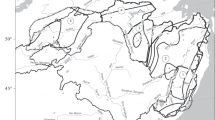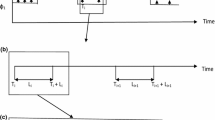Abstract
The multiplicative approach to constructing numerical stochastic models of spatial and spatial-temporal fields of daily liquid precipitation sums on a regular grid is considered. The approach involves independent simulation of precipitation indicator fields with a given correlation function and probabilities of precipitation and fields of precipitation sums with the corresponding correlation function and one-dimensional distribution. The final field is the product of these fields. Verification results for the model on studying properties of statistical characteristics of extreme precipitations are presented.
Similar content being viewed by others
References
S. M. Prigarin and A. Marshak, “Numerical model of broken clouds adapted to results of observations,” Atmos. Ocean. Opt. 18 (3), 236–242 (2005).
Ya. P. Dragan, V. A. Rozhkov, and I. N. Yavorskii, Meth-ods of Probabilistic Analysis of the Rhythm of Oceanolog-ical Processes (Gidrometeoizdat, Leningrad, 1987) [in Russian].
W. Kleiber, R. W. Katz, and B. Rajagopalan, “Daily spatiotemporal precipitation simulation using latent and transformed Gaussian processes,” Water Resour. Res. 48 (1), 11105–11114 (2012).
V. A. Ogorodnikov and S. M. Prigarin, Numerical Mod-elling of Random Processes and Fields: Algorithms and Applications (VSP, Utrecht, 1996).
M. A. Semenov and E. M. Barrow, “Use of a stochastic weather generator in the development of climate change scenarios,” Clim. Change 35 (4), 397–414 (1997).
A. Anisimova, “Numerical simulation of random indica-tor fields of liquid precipitations,” in Proc. of the Confer-ence of Young Scientists of Institute of Computational Mathematics and Mathematical Geophysics SB RAS (ICMMG, Novosibirsk, 1997), pp. 3–15 [in Russian].
O. S. Ukhinova and V. A. Ogorodnikov, “Stochastic models of spatial-time fields of precipitation sums,” in Proc. 6th St. Peterburg Workshop on Simulation, 2009, pp. 193–197.
S. M. Prigarin, Numerical Simulation Methods for Ran-dom Processes and Fields (ICMMG, Novosibirsk, 2005) [in Russian].
A. D. Drobyshev, A. S. Marchenko, V. A. Ogorodnikov, and V. D. Chizhikov, “Statistical structure of time series of daily sums of liquid precipitation in the flat part of Novosibirsk region,” Trudy ZapSibNII Gosko-mgidrometa, No. 86, 44–66 (1989).
A. S. Marchenko, “Approximation of an empirical dis-tribution of probabilities of daily sums of liquid precip-itation,” Trudy ZapSibNII Goskomgidrometa, No. 86, 66–74 (1989).
N. V. Smirnov and L. N. Bol’shev, Tables for Calculations of Normal Distribution Functions (Izv. AN SSSR, Mos-cow, 1962) [in Russian].
S. L Marple, Jr., Digital Spectral Analysis with Applica-tions (Prentice Hall, 1987).
Author information
Authors and Affiliations
Corresponding author
Additional information
Original Russian Text © V.A. Ogorodnikov, O.V. Sereseva, 2015, published in Optika Atmosfery i Okeana.
Rights and permissions
About this article
Cite this article
Ogorodnikov, V.A., Sereseva, O.V. Multiplicative numerical stochastic model of daily sums of liquid precipitation fields and its use for estimating statistical characteristics of extreme precipitation regimes. Atmos Ocean Opt 28, 328–335 (2015). https://doi.org/10.1134/S1024856015040107
Received:
Published:
Issue Date:
DOI: https://doi.org/10.1134/S1024856015040107




